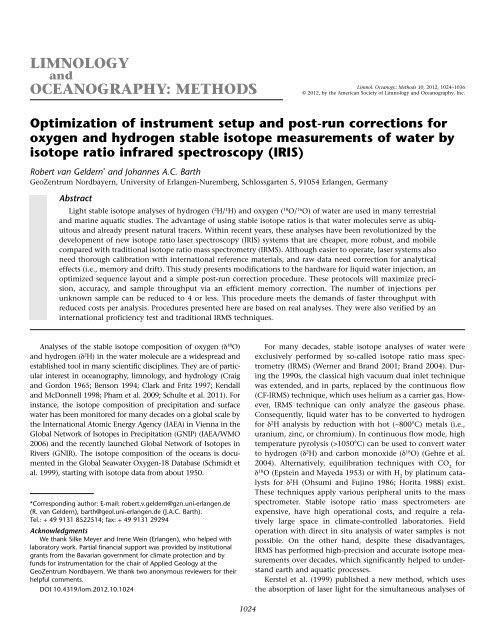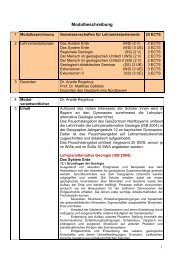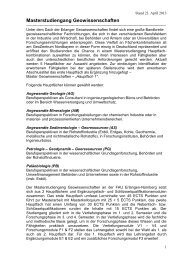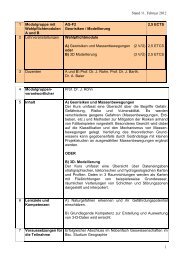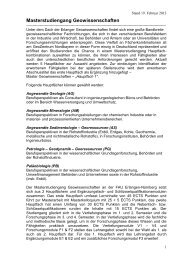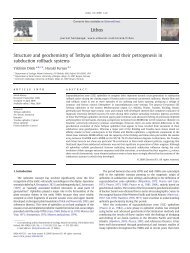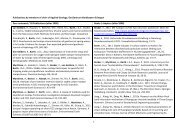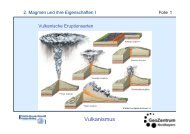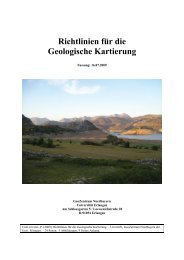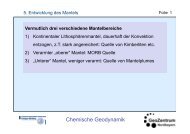Robert van Geldern, Johannes A.C. Barth. 2012. Optimization of ...
Robert van Geldern, Johannes A.C. Barth. 2012. Optimization of ...
Robert van Geldern, Johannes A.C. Barth. 2012. Optimization of ...
You also want an ePaper? Increase the reach of your titles
YUMPU automatically turns print PDFs into web optimized ePapers that Google loves.
LIMNOLOGY<br />
and<br />
OCEANOGRAPHY: METHODS<br />
<strong>Optimization</strong> <strong>of</strong> instrument setup and post-run corrections for<br />
oxygen and hydrogen stable isotope measurements <strong>of</strong> water by<br />
isotope ratio infrared spectroscopy (IRIS)<br />
<strong>Robert</strong> <strong>van</strong> <strong>Geldern</strong> * and <strong>Johannes</strong> A.C. <strong>Barth</strong><br />
GeoZentrum Nordbayern, University <strong>of</strong> Erlangen-Nuremberg, Schlossgarten 5, 91054 Erlangen, Germany<br />
Abstract<br />
Light stable isotope analyses <strong>of</strong> hydrogen ( 2H/ 1H) and oxygen ( 18O/ 16O) <strong>of</strong> water are used in many terrestrial<br />
and marine aquatic studies. The ad<strong>van</strong>tage <strong>of</strong> using stable isotope ratios is that water molecules serve as ubiquitous<br />
and already present natural tracers. Within recent years, these analyses have been revolutionized by the<br />
development <strong>of</strong> new isotope ratio laser spectroscopy (IRIS) systems that are cheaper, more robust, and mobile<br />
compared with traditional isotope ratio mass spectrometry (IRMS). Although easier to operate, laser systems also<br />
need thorough calibration with international reference materials, and raw data need correction for analytical<br />
effects (i.e., memory and drift). This study presents modifications to the hardware for liquid water injection, an<br />
optimized sequence layout and a simple post-run correction procedure. These protocols will maximize precision,<br />
accuracy, and sample throughput via an efficient memory correction. The number <strong>of</strong> injections per<br />
unknown sample can be reduced to 4 or less. This procedure meets the demands <strong>of</strong> faster throughput with<br />
reduced costs per analysis. Procedures presented here are based on real analyses. They were also verified by an<br />
international pr<strong>of</strong>iciency test and traditional IRMS techniques.<br />
Analyses <strong>of</strong> the stable isotope composition <strong>of</strong> oxygen (d 18 O)<br />
and hydrogen (d 2 H) in the water molecule are a widespread and<br />
established tool in many scientific disciplines. They are <strong>of</strong> particular<br />
interest in oceanography, limnology, and hydrology (Craig<br />
and Gordon 1965; Benson 1994; Clark and Fritz 1997; Kendall<br />
and McDonnell 1998; Pham et al. 2009; Schulte et al. 2011). For<br />
instance, the isotope composition <strong>of</strong> precipitation and surface<br />
water has been monitored for many decades on a global scale by<br />
the International Atomic Energy Agency (IAEA) in Vienna in the<br />
Global Network <strong>of</strong> Isotopes in Precipitation (GNIP) (IAEA/WMO<br />
2006) and the recently launched Global Network <strong>of</strong> Isotopes in<br />
Rivers (GNIR). The isotope composition <strong>of</strong> the oceans is documented<br />
in the Global Seawater Oxygen-18 Database (Schmidt et<br />
al. 1999), starting with isotope data from about 1950.<br />
*Corresponding author: E-mail: robert.v.geldern@gzn.uni-erlangen.de<br />
(R. <strong>van</strong> <strong>Geldern</strong>), barth@geol.uni-erlangen.de (J.A.C. <strong>Barth</strong>).<br />
Tel.: + 49 9131 8522514; fax: + 49 9131 29294<br />
Acknowledgments<br />
We thank Silke Meyer and Irene Wein (Erlangen), who helped with<br />
laboratory work. Partial financial support was provided by institutional<br />
grants from the Bavarian government for climate protection and by<br />
funds for instrumentation for the chair <strong>of</strong> Applied Geology at the<br />
GeoZentrum Nordbayern. We thank two anonymous reviewers for their<br />
helpful comments.<br />
DOI 10.4319/lom.<strong>2012.</strong>10.1024<br />
1024<br />
Limnol. Oceanogr.: Methods 10, 2012, 1024–1036<br />
© 2012, by the American Society <strong>of</strong> Limnology and Oceanography, Inc.<br />
For many decades, stable isotope analyses <strong>of</strong> water were<br />
exclusively performed by so-called isotope ratio mass spectrometry<br />
(IRMS) (Werner and Brand 2001; Brand 2004). During<br />
the 1990s, the classical high vacuum dual inlet technique<br />
was extended, and in parts, replaced by the continuous flow<br />
(CF-IRMS) technique, which uses helium as a carrier gas. However,<br />
IRMS technique can only analyze the gaseous phase.<br />
Consequently, liquid water has to be converted to hydrogen<br />
for d 2 H analysis by reduction with hot (~800°C) metals (i.e.,<br />
uranium, zinc, or chromium). In continuous flow mode, high<br />
temperature pyrolysis (>1050°C) can be used to convert water<br />
to hydrogen (d 2 H) and carbon monoxide (d 18 O) (Gehre et al.<br />
2004). Alternatively, equilibration techniques with CO 2 for<br />
d 18 O (Epstein and Mayeda 1953) or with H 2 by platinum catalysts<br />
for d 2 H (Ohsumi and Fujino 1986; Horita 1988) exist.<br />
These techniques apply various peripheral units to the mass<br />
spectrometer. Stable isotope ratio mass spectrometers are<br />
expensive, have high operational costs, and require a relatively<br />
large space in climate-controlled laboratories. Field<br />
operation with direct in situ analysis <strong>of</strong> water samples is not<br />
possible. On the other hand, despite these disad<strong>van</strong>tages,<br />
IRMS has performed high-precision and accurate isotope measurements<br />
over decades, which significantly helped to understand<br />
earth and aquatic processes.<br />
Kerstel et al. (1999) published a new method, which uses<br />
the absorption <strong>of</strong> laser light for the simultaneous analyses <strong>of</strong>
<strong>van</strong> <strong>Geldern</strong> and <strong>Barth</strong> Water stable isotope analysis with IRIS<br />
d 18 O and d 2 H in water vapor. During the last years, this technique<br />
was improved (Kerstel and Gianfrani 2008) and new<br />
commercially available instruments entered the analytical<br />
market. This technique is referred to as stable isotope ratio<br />
infrared spectroscopy (SIRIS or IRIS in the more recent literature;<br />
Chesson et al. 2010). The developers and manufacturers<br />
<strong>of</strong> these instruments highlight some major ad<strong>van</strong>tages over<br />
the traditional IRMS technique. The IRIS method allows direct<br />
measurement <strong>of</strong> water vapor with almost no sample preparation.<br />
Laser-based instruments are cheaper and can be built in<br />
a compact and lightweight design for in situ and real-time<br />
monitoring applications. A number <strong>of</strong> studies showed that the<br />
new IRIS technique yields comparable precision and accuracy<br />
to traditional IRMS (Lis et al. 2008; Gupta et al. 2009; Chesson<br />
et al. 2010; Penna et al. 2010). However, it must be noted that<br />
this method is sensitive to organic contaminations (e.g., alcohol)<br />
in the sample, which may result in wrong analytical<br />
results (Brand et al. 2009). To detect such samples, Picarro Inc.<br />
<strong>of</strong>fers an additional s<strong>of</strong>tware tool (ChemCorrect TM ) that identifies<br />
potentially contaminated samples to the user.<br />
The new laser instruments opened possibilities for analyses<br />
<strong>of</strong> water stable isotopes to laboratories and users that are not<br />
familiar with classic isotope ratio analyses and the specific calibration<br />
and post-run correction strategies that are typically<br />
associated with this analytical method. The crucial point for<br />
correct isotope data are the appropriate implementation and<br />
use <strong>of</strong> isotope-specific correction and normalization procedures.<br />
In many cases, the manufacturers <strong>of</strong> laser isotope ratio<br />
analyzers do not stress the need for such specific procedures.<br />
Therefore, just following the manufacturers’ instructions will<br />
<strong>of</strong>ten not result in high-precision stable isotope analyses. Furthermore,<br />
laboratories without IRMS are not able to verify and<br />
double-check their analytical methods with the new instrument.<br />
Whereas most isotope laboratories running traditional<br />
IRMS can adopt their existing procedures, the increasing<br />
amount <strong>of</strong> new laboratories without such expertise need easyto-follow<br />
methods that enable them to obtain high-precision<br />
isotope data by the IRIS technique.<br />
Various approaches have been used for raw data correction<br />
and calibration <strong>of</strong> isotope data from several peripherals (Nelson<br />
2000; Nelson and Dettman 2001; Werner and Brand 2001;<br />
Brooks et al. 2004; Gehre et al. 2004; <strong>van</strong> <strong>Geldern</strong> and Suckow<br />
2005; Paul et al. 2007; Schmid et al. 2010; Gröning 2011). The<br />
most common approach is data evaluation by spreadsheets<br />
and typically follows general principles that have been<br />
reviewed for example by Werner and Brand (2001). In addition,<br />
some laboratory information management systems<br />
(LIMS), as LIMS for Light Stable Isotopes (Coplen 2000) or Lab-<br />
Data (Suckow and Dumke 2001), also support the import <strong>of</strong><br />
IRMS and IRIS raw data and <strong>of</strong>fer the ability for further data<br />
processing.<br />
The objectives <strong>of</strong> this study are to suggest improvements <strong>of</strong><br />
the hardware with respect to the factory setup <strong>of</strong> laser isotope<br />
analyzers using water injection and to highlight some major<br />
1025<br />
pitfalls associated with this type <strong>of</strong> new instruments. This<br />
includes an optimized procedure for raw data processing. A<br />
focus <strong>of</strong> this study is on memory effects that are among the<br />
major sources <strong>of</strong> error in water stable isotope analyses by liquid<br />
injection. Following the suggestions will enable users to<br />
increase the lifetime <strong>of</strong> consumables (e.g., syringes). At the<br />
same time, they will increase sample throughput, precision,<br />
and accuracy <strong>of</strong> the analyses. In this manner, faster and<br />
improved analytical results will lower the operational costs per<br />
sample. The usability is demonstrated by real world examples<br />
and includes an international round-robin test.<br />
Materials and procedures<br />
Commercially available IRIS instruments for water stable<br />
isotope analyses are produced by Picarro Inc. and Los Gatos<br />
Research Inc. (LGR). Trace gas analyzers based on the older<br />
lead-salt laser technology produced by Campbell Scientific<br />
Inc. are not available anymore but may still be in use for isotope<br />
water vapor measurements. Note that the protocols presented<br />
here (i.e., the memory correction scheme) were developed<br />
for liquid water injection by a vaporizer and cannot be<br />
directly applied to existing other or new sample introduction<br />
systems (e.g., Picarro induction module). In this study, a<br />
Picarro L1102-i WS-CRDS analyzer with vaporization module<br />
V1102-i coupled to a CTC PAL autosampler (CTC Analytics)<br />
has been used. All analyses were done in high precision mode.<br />
The results <strong>of</strong> the Picarro system were compared with traditional<br />
IRMS data, which were analyzed for d18O by an automated<br />
equilibration unit (Gasbench 2, Thermo Scientific) in<br />
continuous flow mode coupled to a Delta plus XP isotope ratio<br />
mass spectrometer.<br />
All values are expressed in the standard delta notation in<br />
per mil (‰) versus VSMOW according to<br />
(1)<br />
where R is the isotope ratio <strong>of</strong> the heavy and light isotope<br />
(e.g., 18O/ 16O) in the sample and the reference. The data were<br />
normalized to the VSMOW/SLAP scale by assigning a value <strong>of</strong><br />
0‰ and –55.5‰ (d18O)/0‰ and –427.5‰ (d2 ⎛ ⎞<br />
d = ⎜ − ⎟<br />
⎝ ⎠<br />
H) to VSMOW2<br />
and SLAP2, respectively. For data normalization, two laboratory<br />
reference waters that were calibrated directly against<br />
VSMOW2 and SLAP2 were measured in each run.<br />
The carry-over <strong>of</strong> residual amounts from one sample to the<br />
other, denoted as memory effect, is expressed as the measure<br />
<strong>of</strong> how close the measurement comes to its ideal (or true)<br />
value after a number <strong>of</strong> repeat injections. The associated memory<br />
coefficient m is defined here as<br />
(2)<br />
×<br />
Rsample<br />
1 1000<br />
Rreference<br />
( n−1)<br />
n<br />
n dt−di mi = ( n−1)<br />
n<br />
d −d<br />
t<br />
whereas i is the number <strong>of</strong> injection <strong>of</strong> sample n. The subscript<br />
t denotes the isotope value that is regarded as the true value <strong>of</strong><br />
the sample. d t represents the value around which results stabi-<br />
t
<strong>van</strong> <strong>Geldern</strong> and <strong>Barth</strong> Water stable isotope analysis with IRIS<br />
lize after numerous injections. It is typically the value <strong>of</strong> the last<br />
injection or is calculated as an average from the last few injections.<br />
For example, a memory coefficient <strong>of</strong> 0.98 means that the<br />
analyzed isotope value represents 98% <strong>of</strong> the true isotope value<br />
<strong>of</strong> the sample. In other words, it is influenced by 2% from the<br />
precursor sample. This definition has the ad<strong>van</strong>tage that it is<br />
independent <strong>of</strong> the absolute difference in delta value <strong>of</strong> two<br />
adjacent samples. It is also independent <strong>of</strong> the direction <strong>of</strong> the<br />
change in delta values (positive or negative).<br />
Modifications to the analytical hardware<br />
After setup <strong>of</strong> the laser spectroscopy system, some modifications<br />
including a change <strong>of</strong> syringe type and number <strong>of</strong><br />
injections compared with the original factory setup have been<br />
applied. This results in lower analytical costs and increased<br />
analytical performance as well as higher sample throughput.<br />
An overview <strong>of</strong> all modifications is provided in Table 1.<br />
One critical point is the lifetime <strong>of</strong> the syringe that can<br />
become a major cost factor. The delivered and recommended<br />
5 µL syringe clogged fast and had to be replaced several times<br />
per month. It was exchanged with a more robust and cheaper<br />
10 µL model (SGE Analytical Science; alternative: Hamilton<br />
Bonaduz AG). The injection volume remained unchanged at<br />
1.8 µL, which yielded a signal height <strong>of</strong> about 20.000 ppmV<br />
H 2 O after vaporization. The reproducibility <strong>of</strong> the injection<br />
volume with the 10 µL syringe was identical to the 5 µL<br />
Table 1. Picarro factory setup versus modifications in the Erlangen stable isotope laboratory.<br />
1026<br />
model. Additionally, a daily manual clean-up <strong>of</strong> the plunger<br />
with N-Methyl-2-pyrrolidone (NMP, technical grade) helped<br />
to significantly increase the syringe lifetime and to reduce<br />
analytical costs. For manual cleaning, it is crucial to take out<br />
the plunger completely and to clean the entire body. This is<br />
important because the uppermost part <strong>of</strong> the syringe and<br />
plunger has been identified as the main source <strong>of</strong> error. This<br />
part <strong>of</strong> the syringe is usually not reached by the automatic<br />
wash cycle <strong>of</strong> the auto sampler and can accumulate crusts,<br />
which will block the plunger. In case <strong>of</strong> persistent crusts, the<br />
syringe can be placed into an ultrasonic bath with deionized<br />
water before NMP cleaning. Note that increasing the number<br />
<strong>of</strong> post-injection wash cycles or use <strong>of</strong> combinations <strong>of</strong> solvents<br />
did not help to keep the plunger running smooth.<br />
Therefore, there is currently no alternative to regular manual<br />
cleaning.<br />
For isotope measurements, it is important to prevent evaporation<br />
<strong>of</strong> the water sample. During the sequence run (typical<br />
up to 24 h), some water will evaporate into the vials headspace<br />
and may subsequently leave via a loose cap. Consequently,<br />
the remaining liquid water becomes enriched in the<br />
heavy isotope relative to the water vapor due to a Rayleigh<br />
fractionation process. Therefore, the 1.5 mL standard GC vials<br />
used in the CTC autosampler must have caps with tight fit.<br />
This is crucial for very low sample volumes and the use <strong>of</strong><br />
Parameter Picarro Inc. factory setup<br />
Modification at Erlangen<br />
stable isotope laboratory Observation<br />
Syringe 5 µL SGE (#001982) 10 µL SGE (#002980)<br />
10 µL Hamilton (#203205/02)<br />
increased syringe lifetime<br />
Vials delivered with Fisher-brand ® vials,<br />
caps with PTFE/silicon septa<br />
Filling volume <strong>of</strong><br />
autosampler vials<br />
Agilent type 1.5 mL vials (thread N9-425); caps<br />
with PTFE/red rubber septa (VWR #548-0907)<br />
Fisher-brand ® caps had bad fit on<br />
thread and were leaky<br />
no recommendation 800 µL High liquid to headspace ratio<br />
minimizes evaporation effects<br />
Injection volume 1.8 µL 1.8 µL (no modification)<br />
Needle rinse 2 pre-injection cleanings with<br />
sample<br />
Wash cycles no recommendation; NMP * is suggested<br />
Memory correction no correction, ignore first 3 injections<br />
2 pre injection cleanings with sample (no modification)<br />
Fresh water: one post-injection wash cycle with<br />
NMP<br />
Salt water: one additional wash cycle with DI<br />
water before NMP<br />
mathematical memory correction based on standard<br />
injections<br />
Nr <strong>of</strong> injections 6 reference waters: 10 samples: 4 (no injection<br />
ignored)<br />
Injection port septa Restek 3 / ” IceBlue 8 ® (#27159)<br />
general-purpose septa; had to be<br />
3<br />
/8 ” ‘Marathon’ long-life silicon septa, from CS-<br />
Chromatographie Service, Germany (#366082);<br />
replaced daily (lifetime ~250 inj.) replaced weekly (lifetime > 600 injections)<br />
increased syringe lifetime<br />
no injection has to be ignored<br />
reduced nr <strong>of</strong> injections for samples,<br />
higher sample throughput<br />
lower maintenance, increased lifetime<br />
<strong>of</strong> the septa; allows for long<br />
sequences over weekends<br />
Other<br />
Daily manual cleaning <strong>of</strong> syringe plunger with NMP increased syringe lifetime<br />
* N-Methyl-2-pyrrolidone (CAS No: 872-50-4)
<strong>van</strong> <strong>Geldern</strong> and <strong>Barth</strong> Water stable isotope analysis with IRIS<br />
micro inserts. For standard analysis, a filling volume <strong>of</strong> 800 µL<br />
is recommended. This minimizes any evaporative effect below<br />
analytical precision. Septa with good re-sealing characteristics<br />
should be used for analyses with multiple injections. Typical<br />
combinations with such characteristics are PTFE/silicon or<br />
PTFE/rubber septa. The filling <strong>of</strong> the vials with samples and<br />
reference waters should be carried out immediately before the<br />
start <strong>of</strong> the sequence. Prefilling <strong>of</strong> autosampler racks with samples<br />
or reference waters and storage overnight is not recommended.<br />
Also, the reuse <strong>of</strong> vials with reference waters in the<br />
next sequence yielded unreliable results and should be<br />
avoided.<br />
Sequence layout<br />
The number <strong>of</strong> injections needed per sample is one <strong>of</strong> the<br />
most important issues with respect to sample throughput and<br />
analytical costs. Furthermore, the general layout <strong>of</strong> a<br />
sequence, i.e., the number and position <strong>of</strong> reference waters<br />
and the number <strong>of</strong> injections has to meet the needs <strong>of</strong> postrun<br />
corrections applied to the raw data. Post-run corrections<br />
applied in isotope analyses depend on the specific characteristics<br />
<strong>of</strong> the sample preparation device. Typical applied corrections<br />
are (1) linearity, (2) sample-to-sample memory, and (3)<br />
drift. Finally, the corrected data set is normalized to the<br />
VSMOW/SLAP scale by assigning calibrated values to two inhouse<br />
reference waters.<br />
Linearity corrections for IRMS are instrument dependent<br />
and are machine specific (Werner and Brand 2001; <strong>Barth</strong> et al.<br />
2004). The injection volume for the IRIS system is kept constant,<br />
which gives a constant signal height in the detector.<br />
Therefore, linearity effects <strong>of</strong> the detector can be neglected.<br />
An optimized standard sequence is shown in Fig. 1. The<br />
scheme was arranged to fulfill the needs <strong>of</strong> corrections (2) and<br />
(3) and the subsequent normalization to the international<br />
scale. The sequence uses four in-house reference waters<br />
(Table 2). These were calibrated directly against primary international<br />
reference materials (VSMOW2, GISP, and SLAP2) that<br />
are distributed by the Reference Products for Environment and<br />
Trade section <strong>of</strong> the IAEA, Vienna, or the National Institute <strong>of</strong><br />
Standards and Technology (NIST). Run times <strong>of</strong> the sequences<br />
are typically less than 24 h to allow for the daily maintenance<br />
<strong>of</strong> the equipment (syringe cleaning, etc.) and data evaluation<br />
to identify potential problems before the preparation and start<br />
<strong>of</strong> the next sequence.<br />
The sequence uses the “high precision” mode <strong>of</strong> the instrument<br />
and begins with the injection <strong>of</strong> the drift-monitoring<br />
water (DEST, Table 2 and Fig. 1). The number <strong>of</strong> injections is<br />
set to 10, whereas the first 3 to 6 injections serve as “warm<br />
ups” for the instrument and are ignored for any further data<br />
evaluation. Injections 7 to 10 serve as the first anchor for the<br />
drift correction function. Other data points for this correction<br />
are drawn from the repeat analyses <strong>of</strong> the DEST reference<br />
water that is distributed regularly over the sequence (vials nr<br />
9, 18, and 27 in Fig. 1). Injections <strong>of</strong> the references are always<br />
performed from a separate vial for three reasons:<br />
1027<br />
(1) The re-injection from a single vial will puncture the septa<br />
several times and the waters can be enriched by evaporation<br />
through leaking septa. The isotope values will shift to<br />
higher numbers over time. This can be wrongly interpreted<br />
as instrument drift.<br />
(2) The filling and analysis <strong>of</strong> individual vials yield better values<br />
<strong>of</strong> the analytical reproducibility throughout a<br />
sequence, because it includes errors and variations from<br />
sample preparation.<br />
(3) The autosampler programming is much faster with this<br />
type <strong>of</strong> setup and can be edited more easily at the CTC<br />
touchpad.<br />
The next step is the injection <strong>of</strong> three isotopically different<br />
waters (named HIS, ANTA, and HERA, see Table 2) with high,<br />
low, and intermediate values. The difference in isotope compositions<br />
results in a distinct sample-to-sample carry over<br />
that is clearly visible in these successive injections. This is<br />
used to calculate memory coefficients on a daily basis for further<br />
data evaluation. The low and high reference waters are<br />
also used to normalize the data to the VSMOW/SLAP scale<br />
after memory and drift correction. The isotope composition<br />
<strong>of</strong> the fourth isotope reference water is chosen to be close to<br />
the expected values <strong>of</strong> the usually analyzed samples in the<br />
laboratory (here: Central European fresh water) and is treated<br />
as a sample with unknown isotope ratio. It is not used to<br />
establish any correction function and serves as an independently<br />
prepared quality control (QC) sample. By recording the<br />
results <strong>of</strong> the QC sample from day to day, this sample is used<br />
to examine the daily accuracy <strong>of</strong> analyses, and to monitor the<br />
long-term precision.<br />
Memory correction<br />
Depending on the difference in isotope values between two<br />
samples, the first injections <strong>of</strong> the successive vial are influenced<br />
by the precursor. The values <strong>of</strong> successive injections<br />
approach a stable isotope value after a certain number <strong>of</strong> injections.<br />
This number <strong>of</strong> injections needed for a stable value<br />
depends on the amplitude <strong>of</strong> the memory effect, which in<br />
turn, depends on the instrument’s design and the magnitude<br />
<strong>of</strong> the isotope difference between samples. Tests indicated that<br />
syringe-type or numbers <strong>of</strong> cleaning cycles are only <strong>of</strong> minor<br />
importance for the amplitude <strong>of</strong> the memory effect. Additional<br />
post injection cleaning cycles with DI water and/or<br />
NMP did not reduce the observed memory effect. Therefore,<br />
the major source <strong>of</strong> the memory effect seems to be related to<br />
the injection port. In traditional IRMS, practically memoryfree<br />
systems such as water equilibration with gaseous CO 2 or<br />
H 2 are available. Other systems with direct conversion <strong>of</strong> the<br />
water sample, such as the reduction <strong>of</strong> H 2 O to H 2 by hot<br />
chromium (Thermo Scientific H/Device) or conversion to H 2<br />
and CO by high temperature pyrolysis show a memory in the<br />
range <strong>of</strong> 2% or less for the first injection (m 1 = 0.98) (Werner<br />
and Brand 2001; Gehre et al. 2004). In case <strong>of</strong> the high temperature<br />
pyrolysis, the memory effect could be reduced by<br />
modifications to the gas flow (Gehre et al. 2004).
<strong>van</strong> <strong>Geldern</strong> and <strong>Barth</strong> Water stable isotope analysis with IRIS<br />
Fig. 1. Typical sequence layout with 27 positions (high precision mode) with four reference waters with 10 injections at the beginning. HIS and ANTA<br />
are the names <strong>of</strong> reference waters with high and low delta values used for scale normalization (Table 2). DEST and HERA are intermediate waters, whereas<br />
DEST is used for drift monitoring and HERA (Vial nr 5) is treated as sample for quality control. Vials nr 2, 3, and 4 are used to calculate memory correction<br />
factors (see text).<br />
In contrast to this, possible changes to the Picarro vaporizer<br />
module are limited to septa material, syringe type, injection and<br />
cleaning parameters, and temperature. Changes in these parameters<br />
had no or negligible influence on the memory effect. The<br />
1028<br />
number <strong>of</strong> injections needed on the IRIS system for a reliable<br />
isotope value is crucial for sample throughput and directly<br />
related to the costs per sample. The main possible approaches to<br />
reduce memory effects can be summarized as follows:
<strong>van</strong> <strong>Geldern</strong> and <strong>Barth</strong> Water stable isotope analysis with IRIS<br />
Table 2. Laboratory reference materials.<br />
Name Type Purpose Source<br />
VSMOW2/GISP/SLAP2 International reference material Calibration <strong>of</strong> in-house reference waters distributed by IAEA and NIST *<br />
In-house waters: HIS high isotope water (d18O: –1.31/d2H: –7.4) Normalization to VSMOW/SLAP scale Sea water, deionized<br />
ANTA low isotope water (d18O: –32.81/d2H: –259.8) Normalization to VSMOW/SLAP scale Antarctic snow, deionized<br />
DEST intermediate water (d18O: –8.82/d2H: –63.3) Drift monitoring Erlangen tap water, deionized<br />
HERA intermediate water (d18O: –6.18/d2H: –53.6) Quality control standard; treated as sample Erlangen tap water, deionized<br />
Memory correction is calculated from subsequent injections <strong>of</strong> HIS, ANTA, and DEST<br />
* Online catalogues can be accessed at http://nucleus.iaea.org/rpst/index.htm (IAEA) and http://www.nist.gov/srm/index.cfm (NIST).<br />
(1) Ignore the first injection(s) <strong>of</strong> a sample and calculate the<br />
final value from the last injections after stabilization <strong>of</strong> the<br />
isotope value. In its standard setup, Picarro Inc. recommends<br />
performing 6 injections per sample, ignoring the<br />
first 3 injections, and averaging the final value from the last<br />
3 injections. This results in large numbers <strong>of</strong> injections per<br />
sample that have to be discarded, and thus, creates analytical<br />
costs. Furthermore, in many cases, the number <strong>of</strong> 6<br />
injections per sample is clearly insufficient to reach a stable<br />
isotope value for d 2 H (Fig. 2). The size <strong>of</strong> error depends on<br />
the magnitude <strong>of</strong> the difference in isotope composition<br />
between two samples. Therefore, by following this procedure,<br />
analytical results may suffer from memory effects.<br />
This is especially true for the isotope reference waters with<br />
high and low d-values that serve for normalization to the<br />
VSMOW/SLAP scale. Correct analysis <strong>of</strong> these references is<br />
essential for high-precision stable isotope values and<br />
ensures comparability <strong>of</strong> data between laboratories.<br />
(2) A mathematical memory correction based on the influence<br />
<strong>of</strong> the previous sample and the sample(s) before. This<br />
approach has been successfully applied to systems with<br />
low memory effects, such as the Thermo Scientific<br />
H/Device. In these systems, the isotope value typically stabilizes<br />
after 3 or 4 injections. A prerequisite for this<br />
approach is that each sample is injected <strong>of</strong>ten enough<br />
until the value is stable. The mathematical correction only<br />
eliminates the need to discard the first injections. The final<br />
value can then be averaged from all injections.<br />
(3) Create a static memory correction table based on “memory<br />
runs.” In these runs, waters with large differences in isotope<br />
values are analyzed numerous times in alternating<br />
sequential arrangement with a sufficient high number <strong>of</strong><br />
injections for each sample (typically 15 to 20 injections).<br />
The average memory coefficients for the injections are<br />
stored in a table, and are used in further sequences for a<br />
mathematical memory correction <strong>of</strong> the analytical results.<br />
This allows for a reduction to 3 or 4 injections per sample.<br />
Templates <strong>of</strong> Bruce Vaughn from the stable isotope laboratory<br />
<strong>of</strong> the Institute <strong>of</strong> Arctic and Alpine Research<br />
(INSTAAR), University <strong>of</strong> Colorado have been provided by<br />
courtesy <strong>of</strong> Picarro Inc. upon request. This approach works<br />
well as long as the memory coefficients do not change. As<br />
1029<br />
Fig. 2. Memory effect on the (A) d 18 O and (B) d 2 H value <strong>of</strong> the injections<br />
<strong>of</strong> a sample analyzed after a sample with a large difference in isotopic<br />
composition (dΔ).<br />
shown below, the memory coefficient is not necessarily<br />
stable over time and may depend on the sample matrix<br />
(e.g., salinity, alkalinity, pH, etc.). A change in sample<br />
matrix always bears the risk <strong>of</strong> an undetected change <strong>of</strong><br />
the memory coefficients. To ensure appropriate and up-todate<br />
memory coefficients, frequent repetitions <strong>of</strong> these<br />
time-consuming runs have to be carried out.<br />
(4) In this study, we suggest a memory correction approach<br />
based on the daily analysis <strong>of</strong> multiple reference waters<br />
that are already incorporated in each sequence for normalization<br />
to the SMOW/SLAP scale. After a fast and simple<br />
iterative determination <strong>of</strong> memory coefficients at the
<strong>van</strong> <strong>Geldern</strong> and <strong>Barth</strong> Water stable isotope analysis with IRIS<br />
beginning <strong>of</strong> each sequence, these coefficients can be<br />
applied to all subsequent injections <strong>of</strong> the sequence. This<br />
ensures use <strong>of</strong> up-to-date memory coefficients for mathematical<br />
memory corrections. Theoretically, after the initial<br />
multiple injection <strong>of</strong> the reference waters one injection per<br />
sample would be sufficient. However, to allow for appropriate<br />
statistical calculations a minimum <strong>of</strong> 4 injections<br />
per sample is recommended. This correction approach is<br />
described in more detail in the following section.<br />
Calculation <strong>of</strong> memory coefficients<br />
For analyses <strong>of</strong> two adjacent samples with a large difference<br />
in their delta values, the number <strong>of</strong> injections required to<br />
obtain a sufficiently stable value needs to be determined. The<br />
maximum differences in delta values (Δd) occur between the<br />
low and high reference waters. For the in-house reference<br />
waters used in this study the maximum Δd values are 31.5‰<br />
(d 18 O) and 252‰ (d 2 H), respectively (Fig. 1, Table 2). This<br />
range usually covers most <strong>of</strong> the naturally occurring samples,<br />
except for some ice core samples or samples from extreme<br />
environments such as deserts or polar regions.<br />
The number <strong>of</strong> injections necessary to obtain a stable value<br />
for the correction procedure can be determined from Fig. 2.<br />
For the oxygen isotope composition (d 18 O) the raw delta value<br />
is within the range <strong>of</strong> the generally cited analytical uncertainty<br />
<strong>of</strong> 0.1‰ after 5 to 7 injections. For hydrogen, the situation<br />
is different and 10 to 12 injections are needed to<br />
securely reach the 1‰ corridor around a steady value. This is<br />
typically regarded as the analytical uncertainty for d 2 H. It must<br />
be noted here that the number <strong>of</strong> injections needed for a stable<br />
isotope value depends on the absolute difference dΔ<br />
between two samples. For a larger dΔ (427.5‰ in d 2 H for<br />
VSMOW2 and SLAP2), the number <strong>of</strong> injections for a stable<br />
value can be significantly higher (Gröning 2011). The number<br />
<strong>of</strong> repeat injections has to be evaluated for the used laboratory<br />
reference waters. For the following calculation <strong>of</strong> the memory<br />
coefficients, we determined that the necessary stable value<br />
within the analytical uncertainty is achieved after ten injections.<br />
This is definitely true for d 18 O, whereas it is a practical<br />
compromise for d 2 H. Numerous tests indicated that no further<br />
analytical accuracy and precision is gained for a dΔ <strong>of</strong> 24‰ to<br />
34‰ (d 18 O) and 196‰ to 252‰ (d 2 H) with more than 10<br />
injections <strong>of</strong> the three in-house reference waters.<br />
In principle, the memory coefficients can be calculated by<br />
using only one pair <strong>of</strong> reference waters. This, however, results<br />
in a poor correction <strong>of</strong> the other reference waters because no<br />
statistical variations <strong>of</strong> the raw data are considered. By using<br />
three successive injections, the full range <strong>of</strong> small and large Δd,<br />
as well as positive and negative changes, are taken into<br />
account. The laboratory reference water with the most positive<br />
isotope value is named HIS, the most negative is named<br />
ANTA, and the intermediate water is named DEST (Table 2).<br />
Three successive injections <strong>of</strong> DEST to HIS, HIS to ANTA, and<br />
ANTA to DEST were used for the determination <strong>of</strong> the memory<br />
coefficients (see Fig. 1 for dΔ amplitudes). The sample stan-<br />
1030<br />
dard deviation (s.d.) <strong>of</strong> the ten injections <strong>of</strong> each vial is calculated<br />
for HIS (vial nr 2), ANTA (nr 3), and DEST (nr 4). The<br />
standard deviation <strong>of</strong> the raw delta values without memory<br />
correction is large (>0.2‰ for d 18 O and >3‰ for d 2 H) due to<br />
the influence <strong>of</strong> the previous sample on the first injections<br />
(see Fig. 2). The weighted mean <strong>of</strong> the combined standard<br />
deviation (c.s.d.) is calculated according to:<br />
2<br />
csd .. . = (. sd.) n<br />
i<br />
∑<br />
n=<br />
1<br />
with (s.d.) 2 being the variance <strong>of</strong> all injections i <strong>of</strong> vial number<br />
n. The variance is defined as the square <strong>of</strong> the standard deviation.<br />
Using the variance instead <strong>of</strong> the standard deviation<br />
results in a larger influence <strong>of</strong> the large isotopic shifts (Δd)<br />
whereas smaller shifts assume a lesser weight in the calculated<br />
c.s.d. This weighted approach takes into account that for a<br />
small Δd between two successive samples, the delta values <strong>of</strong><br />
the first injections are influenced less by the previous vial<br />
compared with larger differences between samples. In other<br />
words, samples that have a larger memory effect are considered<br />
to a larger extent.<br />
For the analyses <strong>of</strong> real environmental samples, the isotope<br />
values typically group in narrow ranges for a specific type <strong>of</strong><br />
sample and <strong>of</strong>ten do not show extreme dΔ changes from one<br />
sample to the other. The weighted approach according to Eq. 3<br />
also efficiently hampers the “overcorrection” <strong>of</strong> an injection.<br />
This problem <strong>of</strong>ten becomes obvious in analyses <strong>of</strong> real world<br />
samples by using an unweighted approach or a simple arithmetic<br />
mean for the determination <strong>of</strong> the memory coefficients.<br />
The determination <strong>of</strong> the memory coefficients m 1 to m 10 is<br />
performed by the “solver” function <strong>of</strong> Micros<strong>of</strong>t Excel. This<br />
starts an iterative process with the constraint to minimize the<br />
c.s.d value. There is no mathematical function fitted to the<br />
memory coefficients. The program varies the numbers for the<br />
coefficients in order to find values that yield a minimum value<br />
for c.s.d. The presettings for the solver function are specified as<br />
follows: (1) Constraint: minimization <strong>of</strong> c.s.d.; (2) no correction<br />
for last injection: m 10 = 1.0. This assumes that the last injection<br />
is the best representative <strong>of</strong> the true isotope value d t ; (3) m is<br />
monotonically increasing or remains identical: m i ≥ m i – 1. This<br />
means the memory effect becomes smaller from one injection<br />
to the next. When a stable value is reached m does not change<br />
anymore; (4) for all memory coefficients: m i ≤ 1.0. There will be<br />
no value larger than 1, which already means no memory.<br />
After correction, the c.s.d and the s.d. <strong>of</strong> the reference<br />
waters are minimal, and a linear regression through the memory<br />
corrected isotope values <strong>of</strong> all injections <strong>of</strong> a vial should<br />
have a slope <strong>of</strong> close to zero (Fig. 3).<br />
The determined memory coefficients m i now can be used to<br />
correct the raw delta values <strong>of</strong> the analyzed samples. After this<br />
correction, all injections can be used to calculate the arithmetic<br />
average, and no injections have to be discarded. With<br />
this, the number <strong>of</strong> injections for samples can be significantly<br />
reduced, because it is not necessary anymore to wait for the<br />
(3)
<strong>van</strong> <strong>Geldern</strong> and <strong>Barth</strong> Water stable isotope analysis with IRIS<br />
Fig. 3. Effect <strong>of</strong> the memory correction described in the text on the raw<br />
delta values <strong>of</strong> the three in-house reference waters (HIS, ANTA, DEST). All<br />
injections <strong>of</strong> a sample can be used after correction; no injection has to be<br />
discarded. Note that d-values are not scaled to the SMOW/SLAP scale.<br />
memory effect to fade away. The samples are injected 4 times<br />
in the standard sequence (Fig. 1). At the same time, the use <strong>of</strong><br />
the memory correction increases accuracy and precision<br />
because the corrected values are not influenced by the previous<br />
sample, and all corrected values can be used.<br />
The memory-corrected values for injection i <strong>of</strong> a vial n are<br />
calculated according to<br />
n−1)<br />
memory corrected i ( raw ) i ( i( raw)<br />
t )<br />
n<br />
n (<br />
d = d + ( 1−<br />
m ) × d −d<br />
where m is the memory coefficient <strong>of</strong> the corresponding injec-<br />
i<br />
(n–1) tion number and d the true isotope value <strong>of</strong> the previous<br />
t<br />
sample. As the best approximation, d is set equal to the value<br />
t<br />
(4)<br />
1031<br />
Fig. 4. Memory coefficient <strong>of</strong> the first injection over time (shown interval<br />
is about 1 y). Usually only fresh water is analyzed. Seawater and brackish<br />
water were injected between 15-17 and 20-22 Jun 2011 (marked by<br />
vertical lines). The vaporizer was manually cleaned at 6 Mar <strong>2012.</strong><br />
<strong>of</strong> the last injection for the previous vial. The memory coefficient<br />
<strong>of</strong> the last injection (m 10 ) is set to 1.0 (see above). Therefore,<br />
the raw value is identical to the memory corrected value<br />
for this injection.<br />
Stability <strong>of</strong> memory coefficients over time<br />
Note that the memory effect may change over time. Fig. 4<br />
shows the calculated d 18 O memory coefficient for the first injection<br />
for about 1 year <strong>of</strong> analytical performance with 70<br />
sequences. The instrument mainly analyzed ground- and surface<br />
water samples, however two sets <strong>of</strong> seawater and brackish<br />
water were injected in June 2011. After these sequences, the<br />
matrix change <strong>of</strong> sample caused an increase <strong>of</strong> the memory<br />
effect. An increase <strong>of</strong> the sample-to-sample carry-over corresponds<br />
to a smaller number <strong>of</strong> the memory coefficient that<br />
dropped from values around 0.97 to values around 0.94. The<br />
main suspected process for this larger memory was salt deposition<br />
from seawater in the injection port <strong>of</strong> the vaporizer module.<br />
The subsequent injection <strong>of</strong> 10 sequences <strong>of</strong> fresh water<br />
samples between July and October did not change the memory<br />
coefficient, and it stayed around a value <strong>of</strong> 0.94. Note that this<br />
time period also coincided with a lesser frequency <strong>of</strong> sequences<br />
during the summer break. In October 2011, the memory effect<br />
<strong>of</strong> the first injection started to decrease, a fact that can be clearly<br />
seen by the rising numbers for m 1 in Fig. 4. The vaporizer had<br />
not been cleaned at this stage. The vaporizer was manually<br />
cleaned with deionized water on the 6 Mar 2011. Surprisingly,<br />
this procedure had hardly any noticeable influence on the<br />
memory effect. This one-year record emphasizes the need to use<br />
up-to-date memory coefficients for any mathematical correction<br />
<strong>of</strong> the raw data. This supports the procedure to determine<br />
the memory correction coefficients in each sequence.
<strong>van</strong> <strong>Geldern</strong> and <strong>Barth</strong> Water stable isotope analysis with IRIS<br />
Drift<br />
For drift monitoring, an in-house reference water (DEST)<br />
with an isotope value in the range <strong>of</strong> the usually analyzed<br />
samples is regularly re-analyzed in the sequence (Fig. 1). A<br />
nearly equidistant spacing <strong>of</strong> this interval is important for<br />
the correct calculation <strong>of</strong> a regression through the data. Also,<br />
the number <strong>of</strong> 4 injections is kept constant for each analysis<br />
<strong>of</strong> DEST. Otherwise, the regression would be influenced by<br />
the higher density <strong>of</strong> data points in one interval and may<br />
bias the drift over time. Therefore, the first 6 injections <strong>of</strong><br />
DEST from position number 1 are ignored and are treated as<br />
“warm-up injections.” This number could be reduced in continuously<br />
running systems. However, after intervals, where<br />
the system has been shut <strong>of</strong>f, up to 6 injections allow stabilization<br />
<strong>of</strong> both signal height and delta values. For drift correction,<br />
a linear regression is calculated from the memorycorrected<br />
data. The slope <strong>of</strong> the regression line applies to<br />
further correct the memory-corrected delta values as a function<br />
<strong>of</strong> time according to<br />
d drift corrected = d memory corrected + (slope × n) (5)<br />
where n is the position in the sequence that correlates to the<br />
analysis time.<br />
Typically, the system used in this study shows no or a small<br />
linear drift. For fresh waters the absolute change in mean dvalues<br />
between the first and last set <strong>of</strong> four injections <strong>of</strong> the<br />
drift reference water over 24 h is typically
<strong>van</strong> <strong>Geldern</strong> and <strong>Barth</strong> Water stable isotope analysis with IRIS<br />
Table 3. Comparison <strong>of</strong> d 18 O values (in ‰ versus VSMOW) analyzed on a memory free IRMS system by equilibration (Gasbench II)<br />
and Picarro IRIS data. The Picarro ran in high precision mode and data have been corrected by the scheme described in the text. Table<br />
is sorted by <strong>of</strong>fset.<br />
LIMS ID Picarro (IRIS) * Gasbench (IRMS) † Offset<br />
W-1760 –9.06 –9.16 0.10<br />
W-1759 –8.98 –9.05 0.07<br />
W-1762 –8.89 –8.95 0.06<br />
W-1758 –9.25 –9.31 0.06<br />
W-1770 –5.33 –5.39 0.05<br />
W-1764 –0.59 –0.63 0.04<br />
W-1766 –1.49 –1.53 0.04<br />
W-1761 –8.72 –8.75 0.03<br />
W-1771 –2.88 –2.91 0.02<br />
W-1757 –9.37 –9.39 0.02<br />
W-1772 –4.42 –4.45 0.02<br />
W-1763 –2.87 –2.89 0.02<br />
W-1752 –9.05 –9.07 0.02<br />
W-1755 –9.22 –9.23 0.01<br />
W-1756 –9.23 –9.24 0.01<br />
W-1765 –1.99 –2.01 0.01<br />
W-1753 –9.16 –9.15 –0.01<br />
W-1769 –2.56 –2.55 –0.01<br />
W-1768 –1.92 –1.90 –0.02<br />
W-1774 –1.51 –1.49 –0.03<br />
W-1767 –0.61 –0.58 –0.03<br />
W-1773 –3.81 –3.77 –0.04<br />
W-1754<br />
* Mean value <strong>of</strong> four injections from one vial.<br />
† Mean value <strong>of</strong> two analyses from two vials.<br />
–9.23 –9.17 –0.06<br />
Table 4. Results <strong>of</strong> the IAEA-TEL-2011-01 pr<strong>of</strong>iciency test. The samples were analyzed in a routine sequence according to Fig. 1, and<br />
raw data were post-run corrected for memory and drift as described in the text.<br />
IAEA values * Reported value<br />
(all values in ‰ versus VSMOW) by Erlangen laboratory Offset<br />
d18O (± 2 s.d.) d2H (± 2 s.d.) d18O d2H d18O d2H Sample 1 0.39 (±0.04) –1.2 (± 0.4) 0.35 –1.2 –0.04 0.0<br />
Sample 2 –5.34 (±0.04) –43.3 (± 0.3) –5.38 –43.7 –0.04 –0.4<br />
Sample 3 –10.05 (±0.04) –72.9 (± 0.4) –10.03 –72.5 0.02 0.4<br />
Sample 4 –15.39 (±0.04) –114.0 (± 0.4) –15.42 –113.7 –0.03 0.3<br />
* Final report is not yet published by IAEA. Values are from IAEA’s <strong>of</strong>ficial individual evaluation report.<br />
TEL-2011-01). Four unknown water samples were analyzed<br />
according to the scheme described in this study and raw data<br />
were processed with the correction procedures presented<br />
above. The samples were analyzed in a routine sequence. The<br />
reported results were within the analytical uncertainty given<br />
by the IAEA. Offsets between the reported and the true value<br />
were smaller than 0.05‰ for d 18 O and 0.5‰ for d 2 H (Table 4).<br />
Discussion<br />
The new laser-based IRIS systems have led to a significant<br />
increase in the number <strong>of</strong> laboratories performing iso-<br />
1033<br />
tope analyses over the last years. In addition, this technique<br />
is the first analytical equipment that can be operated<br />
outside the laboratory for real in situ measurements<br />
even in remote locations or on research vessels. This <strong>of</strong>fers<br />
exciting new possibilities in various water-related research<br />
fields. Nonetheless, high accuracy and precision is still<br />
expected for results. In most cases, this conflicts with sample<br />
throughput, and sometimes, with environmental operational<br />
conditions. This study presents a detailed description<br />
that maximizes precision, accuracy and sample<br />
throughput.
<strong>van</strong> <strong>Geldern</strong> and <strong>Barth</strong> Water stable isotope analysis with IRIS<br />
Table 5. Gain in precision by applying the memory correction described in the text is demonstrated by the analysis <strong>of</strong> samples with<br />
a large difference in d-values. In-house reference waters HIS and ANTA were treated as unknown samples and analyzed in a standard<br />
sequence with 4 injections per vial on positions 6 and 7. Raw values were corrected for memory and drift and were normalized to the<br />
VSMOW/SLAP scale. Offset after corrections between analyzed and defined value is below 1‰ for d 2 H. All d-values are in per mil.<br />
d2H d2H d2H d2H d2Hmean Vial nr Inj. Nr Sample (raw) * (mem. corr.) (drift corr.) (norm.) (± 1 s.d.) d2Hdefined <strong>of</strong>fset<br />
5 4 HERA –65.6 –65.5 –65.5 –54.3<br />
6 1 HIS –23.6 –18.7 –18.7 –7.9 –7.9 (± 0.2) –7.4 –0.5<br />
6 2 HIS –20.4 –18.9 –18.8 –8.1<br />
6 3 HIS –19.3 –18.4 –18.4 –7.6<br />
6 4 HIS –19.5 –18.9 –18.9 –8.1<br />
7 1 ANTA –247.2 –273.7 –273.6 –260.4 –260.3 (± 0.1) –259.8 –0.5<br />
7 2 ANTA –265.1 –273.4 –273.3 –260.1<br />
7 3 ANTA –269.0 –273.5 –273.5 –260.3<br />
7 4 ANTA –270.7 –273.6 –273.5 –260.3<br />
* Note that d-values <strong>of</strong> raw data depend on the user defined slope and intercept in the Picarro s<strong>of</strong>tware. See instrument manual for editing these entries.<br />
The intention <strong>of</strong> this study was to present (1) modifications<br />
<strong>of</strong> the hardware, and (2) an optimized, easy-to-follow protocol<br />
for sequence layout and data evaluation.<br />
Proposed hardware modifications will significantly increase<br />
syringe lifetime, even with the analysis <strong>of</strong> problematic waters<br />
as saline brines. Memory corrections presented here are based<br />
on the actual measured data in the analytical sequence. With<br />
this, they also account for potential variations in the memory.<br />
The number <strong>of</strong> injections per unknown sample can be reduced<br />
to 4 or less injections per sample vial. This means that unnecessary<br />
injections that will be ignored at a later stage are not<br />
needed anymore. It, therefore, meets the demands <strong>of</strong> faster<br />
throughput with reduced costs per analysis.<br />
The gain in precision is demonstrated in Table 5 by the<br />
analysis <strong>of</strong> the in-house reference waters HIS and ANTA as<br />
unknown samples in a standard sequence. This represents a<br />
rather extreme example with a Δd <strong>of</strong> 252‰ (d 2 H) between<br />
the high and low reference water. Typically, differences in a<br />
group <strong>of</strong> real samples are much smaller. After memory correction,<br />
the carry-over from the previous sample has been<br />
virtually removed by the mathematical memory correction,<br />
and corrected values show a low standard deviation. After a<br />
minor drift correction and normalization to the<br />
SMOW/SLAP scale, the final mean values are in very good<br />
agreement with the defined values (i.e., the values <strong>of</strong> the references<br />
waters obtained by direct calibration against<br />
VSMOW2 and SLAP2). No injection has to be ignored. The<br />
accuracy <strong>of</strong> the method has been demonstrated independently<br />
by intra-laboratory tests and an international pr<strong>of</strong>iciency<br />
test (see above).<br />
The Excel template used in this study with corrections for<br />
memory, drift and scale normalization will rely exclusively on<br />
standard features implemented in MS Office without the need<br />
to run macros, additional code written in Visual Basic for<br />
Applications (VBA), or to use database-related s<strong>of</strong>tware such as<br />
1034<br />
MS Access or SQL Server. Complex definition or adjustments<br />
<strong>of</strong> mathematical functions that describe the characteristics <strong>of</strong><br />
the memory effect are not necessary. The presented algorithm<br />
is robust against over-correction <strong>of</strong> the data, a problem that<br />
sometimes raises criticism in connection with the use <strong>of</strong> postrun<br />
corrections.<br />
Comments and recommendations<br />
This study showed that careful post-run correction <strong>of</strong> stable<br />
isotope raw data is unavoidable, irrespective <strong>of</strong> manufacturers’<br />
recommendations. Therefore, it is important to understand<br />
every post-run correction step and to thoroughly evaluate<br />
influences <strong>of</strong> the analytical hardware on results. Nonetheless,<br />
whenever post-run corrections fail to improve raw data or QC<br />
samples do not fulfill the required criteria, the best option is<br />
to re-analyze individual samples or to restart the whole<br />
sequence. It is also important that international isotope reference<br />
materials are used to calibrate suitable and properly<br />
stored in-house reference waters. We encourage all stable isotope<br />
users to use the evaluation scheme and suggest further<br />
enhancements on the post-run correction procedures.<br />
The Micros<strong>of</strong>t Excel template is available as supplementary<br />
material to this article as Web Appendix 1 and directly from<br />
the corresponding author. The spreadsheets were created and<br />
tested on MS Office 2007 for Windows. There may be limitations<br />
in older versions or on other operating systems.<br />
References<br />
<strong>Barth</strong>, J. A. C., A. Tait, and M. Bolshaw. 2004. Automated<br />
analyses <strong>of</strong> 18O/16O ratios in dissolved oxygen from 12mL<br />
water samples. Limnol. Oceanogr. Methods 2:35-41<br />
[doi:10.4319/lom.2004.2.35].<br />
Benson, L. V. 1994. Stable isotopes <strong>of</strong> oxygen and hydrogen in<br />
the Truckee River-Pyramid Lake surface-water system. 1.<br />
Data analysis and extraction <strong>of</strong> paleoclimatic information.
<strong>van</strong> <strong>Geldern</strong> and <strong>Barth</strong> Water stable isotope analysis with IRIS<br />
Limnol. Oceanogr. 39:344-355 [doi:10.4319/lo.1994.39.<br />
2.0344].<br />
Brand, W. A. 2004. Mass spectrometer hardware for analyzing<br />
stable isotope ratios, p. 835-856. In P. A. De Groot [ed.],<br />
Handbook <strong>of</strong> stable isotope analytical techniques, Vol. I.<br />
Elsevier.<br />
———, H. Geilmann, E. R. Crosson, and C. W. Rella. 2009.<br />
Cavity ring-down spectroscopy versus high-temperature<br />
conversion isotope ratio mass spectrometry; a case study on<br />
d2H and d18O <strong>of</strong> pure water samples and alcohol/water<br />
mixtures. Rapid Commun. Mass Spec. 23:1879-1884<br />
[doi:10.1002/rcm.4083].<br />
Brooks, P. D., S. He, P. Dillion, and T. E. Dawson. 2004. Drift in<br />
the quality control standards using chromium-reactor for<br />
D/H analysis <strong>of</strong> water. In Abstracts volume <strong>of</strong> the Joint<br />
European Stable Isotope Users group Meeting (JESIUM), 30<br />
Aug–3 Sep 2004 .<br />
Chesson, L. A., G. J. Bowen, and J. R. Ehleringer. 2010. Analysis<br />
<strong>of</strong> the hydrogen and oxygen stable isotope ratios <strong>of</strong> beverage<br />
waters without prior water extraction using isotope<br />
ratio infrared spectroscopy. Rapid Commun. Mass Spec.<br />
24:3205-3213 [doi:10.1002/rcm.4759].<br />
Clark, I., and P. Fritz. 1997. Environmental isotopes in hydrology.<br />
Lewis.<br />
Coplen, T. 2000. A guide for the laboratory information system<br />
(LIMS) for light stable isotopes. U.S. Geological Survey<br />
Open-File Report 00-345. USGS .<br />
Craig, H., and L. I. Gordon. 1965. Deuterium and oxygen 18<br />
variations in the ocean and marine atmosphere, p. 9-130.<br />
In E. Tongiogi [ed.], Proc. stable isotopes in oceanographic<br />
studies and paleotemperatures. V. Lishi e F., Pisa.<br />
Epstein, S., and T. Mayeda. 1953. Variation <strong>of</strong> O 18 content <strong>of</strong><br />
waters from natural sources. Geochim. Cosmochim. Acta<br />
4:213-224 [doi:10.1016/0016-7037(53)90051-9].<br />
Gehre, M., H. Geilmann, J. Richter, R. A. Werner, and W. A.<br />
Brand. 2004. Continuous flow 2H/1H and 18O/ 16O analysis<br />
<strong>of</strong> water samples with dual inlet precision. Rapid Commun.<br />
Mass Spec. 18:2650-2660 [doi:10.1002/rcm.1672].<br />
Gröning, M. 2011. Improved water d2H and d18O calibration<br />
and calculation <strong>of</strong> measurement uncertainty using a simple<br />
s<strong>of</strong>tware tool. Rapid Commun. Mass Spec. 25:2711-2720<br />
[doi:10.1002/rcm.5074].<br />
Gupta, P., D. Noone, J. Galewsky, C. Sweeney, and B. H.<br />
Vaughn. 2009. Demonstration <strong>of</strong> high-precision continuous<br />
measurements <strong>of</strong> water vapor isotopologues in laboratory<br />
and remote field deployments using wavelengthscanned<br />
cavity ring-down spectroscopy (WS-CRDS)<br />
technology. Rapid Commun. Mass Spec. 23:2534-2542<br />
[doi:10.1002/rcm.4100].<br />
Horita, J. 1988. Hydrogen isotope analysis <strong>of</strong> natural waters<br />
using an H 2 -water equilibration method: A special implication<br />
to brines. Chem. Geol. 72:89-94.<br />
1035<br />
IAEA/WMO. 2006. Global network <strong>of</strong> isotopes in precipitation.<br />
The GNIP database. .<br />
Kendall, C., and J. J. McDonnell [eds.]. 1998. Isotope tracers in<br />
catchment hydrology. Elsevier Science Publishers.<br />
Kerstel, E., and L. Gianfrani. 2008. Ad<strong>van</strong>ces in laser-based isotope<br />
ratio measurements: selected applications. Appl. Phys.<br />
B Lasers Optics 92:439-449 [doi:10.1007/s00340-008-3128-x].<br />
Kerstel, E. R. T., R. Van Trigt, N. Dam, J. Reuss, and H. A. J. Meijer.<br />
1999. Simultaneous determination <strong>of</strong> the 2H/1H,<br />
17O/16O, and 18O/16O isotope abundance ratios in water<br />
by means <strong>of</strong> laser spectrometry. Anal. Chem. 71:5297-5303<br />
[doi:10.1021/ac990621e].<br />
Lis, G., L. I. Wassenaar, and M. J. Hendry. 2008. High-precision<br />
laser spectroscopy D/H and O-18/O-16 measurements <strong>of</strong><br />
microliter natural water samples. Anal. Chem. 80:287-293<br />
[doi:10.1021/ac701716q].<br />
Nelson, S. T. 2000. A simple, practical methodology for routine<br />
VSMOW/SLAP normalization <strong>of</strong> water samples analyzed<br />
by continuous flow methods. Rapid Commun. Mass<br />
Spec. 14:1044-1046 [doi:10.1002/1097-0231(20000630)14:<br />
123.0.CO;2-3].<br />
———, and D. Dettman. 2001. Improving hydrogen isotope<br />
ratio measurements for on-line chromium reduction systems.<br />
Rapid Commun. Mass Spec. 15:2301-2306<br />
[doi:10.1002/rcm.508].<br />
Ohsumi, T., and H. Fujino. 1986. Isotope exchange technique<br />
for preparation <strong>of</strong> hydrogen gas in mass spectrometric D/H<br />
analysis <strong>of</strong> natural waters. Anal. Sci. 2:489-490<br />
[doi:10.2116/analsci.2.489].<br />
Paul, D., G. Skrzypek, and I. Fórizs. 2007. Normalization <strong>of</strong><br />
measured stable isotopic compositions to isotope reference<br />
scales—A review. Rapid Commun. Mass Spec. 21:3006-3014<br />
[doi:10.1002/rcm.3185].<br />
Penna, D., and others. 2010. On the reproducibility and<br />
repeatability <strong>of</strong> laser absorption spectroscopy measurements<br />
for d 2 H and d 18 O isotopic analysis. Hydrol. Earth<br />
Syst. Sci. 14:1551-1566 [doi:10.5194/hess-14-1551-2010].<br />
Pham, S. V., P. R. Leavitt, S. McGowan, B. Wissel, and L. I.<br />
Wassenaar. 2009. Spatial and temporal variability <strong>of</strong> prairie<br />
lake hydrology as revealed using stable isotopes <strong>of</strong> hydrogen<br />
and oxygen. Limnol. Oceanogr. 54:101-118<br />
[doi:10.4319/lo.2009.54.1.0101].<br />
Schmid, M., K. Maseyk, C. Lett, P. Biron, P. Richard, T. Bariac,<br />
and U. Seibt. 2010. Concentration effects on laser-based<br />
del(18)O and del(2)H measurements and implications for<br />
the calibration <strong>of</strong> vapour measurements with liquid standards.<br />
Rapid Commun. Mass Spec. 24:3553-3561<br />
[doi:10.1002/rcm.4813].<br />
Schmidt, G. A., G. R. Bigg, and E. J. Rohling. 1999. Global seawater<br />
oxygen-18 database-v.1.2. .<br />
Schulte, P., and others. 2011. Applications <strong>of</strong> stable water and<br />
carbon isotopes in watershed research: Weathering, carbon<br />
cycling, and water balances. Earth-Sci. Rev. 109:20-31
<strong>van</strong> <strong>Geldern</strong> and <strong>Barth</strong> Water stable isotope analysis with IRIS<br />
[doi:10.1016/j.earscirev.2011.07.003].<br />
Suckow, A., and I. Dumke. 2001. A database system for geochemical,<br />
isotope hydrological and geochronological laboratories.<br />
Radiocarbon 43:325-337.<br />
<strong>van</strong> <strong>Geldern</strong>, R., and A. Suckow. 2005. Correction strategies in<br />
deuterium analysis using chromium reduction. In Abstracts<br />
<strong>of</strong> the 15th Annual Goldschmidt Conference, May 2005,<br />
1036<br />
Moscow (Idaho). Geochim. Cosmochim. Acta 69:A866.<br />
Werner, R. A., and W. A. Brand. 2001. Referencing strategies<br />
and techniques in stable isotope ratio analysis. Rapid Commun.<br />
Mass Spec. 15:501-519 [doi:10.1002/rcm.258].<br />
Submitted 22 May 2012<br />
Revised 24 October 2012<br />
Accepted 2 November 2012


